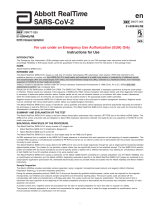Page is loading ...

Cell-Free DNA Collection Tube
February 2016 1 / 2 1014979EN Rev B English
07785666001
50
07832389001
1,200
INTENDED USE
The Roche Cell-Free DNA Collection Tube is a direct draw whole blood
collection tube intended for collection, stabilization, and transportation of
whole blood specimens, and for the preservation of nucleated cells to
enable analysis of cell-free DNA.
PRINCIPLE OF THE PROCEDURE
The Cell-Free DNA Collection Tube is a sterile, evacuated tube that contains
K
3
EDTA plus a cell preservative. The vacuum ensures a correct blood draw
volume. The K
3
EDTA chelates calcium ions, and thereby prevents blood
coagulation. The cell preservative prevents lysis of nucleated blood cells.
LIMITATIONS
For In vitro diagnostic use.
For Professional Use Only.
The Cell-Free DNA Collection Tube is not intended for pediatric blood
draws.
The Cell-Free DNA Collection Tube is not intended for analytes other
than cell-free DNA.
MATERIALS AND METHODS
Materials Provided
The package contains:
Component
Description
Cell-Free DNA
Collection Tube
An evacuated plastic single-use blood collection
tube with 8.5 mL nominal liquid capacity,
designed to be used in conjunction with
standard phlebotomy equipment to collect whole
blood by venipuncture.
Materials Required But Not Provided
Disposable gloves and personal protective equipment
Blood collection needles and multi-tube collection devices for 16 mm X
100 mm tubes
Alcohol swab for cleansing site
Tourniquet
Gauze pads
Bandage
Sharps disposal container for disposal of used materials
Storage, Shipping and Handling
Prior to blood collection, the Cell-Free DNA Collection Tube is stable
through the expiration date when stored between 18-25°C.
Blood specimens collected in the Cell-Free DNA Collection Tube are
stable for 7 days when stored or shipped between 18-25°C, with transient
excursions of up to 16 hours to 15-30°C.
WARNINGS AND PRECAUTIONS
Do not use products after their expiration date.
DO NOT REFRIGERATE OR FREEZE.
Avoid contact of reagents with skin and mucous membranes. In case of
eye contact, rinse thoroughly with plenty of water for at least 15 minutes.
In case of skin contact, wash off with soap and plenty of water.
Treat all biological specimens and materials coming in contact with them
as biohazards. Handle with proper caution and dispose of in accordance
with the policies and procedures of your facility.
Practice universal precautions. Use protective personal equipment and
other engineering controls to protect from blood splatter, blood leakage,
and potential exposure to blood borne pathogens.
Use caution when handling to avoid dropping or breakage of the Cell-
Free DNA Collection Tube.
Do not use the Cell-Free DNA Collection Tube if the contents are cloudy
or if foreign matter is present.
Do not use the Cell-Free DNA Collection Tube for collection of materials
intended for injection.
Do not transfer a collected specimen into the Cell-Free DNA Collection
Tube using a needle and syringe. Additional manipulation of sharps
increases the risk of injury.
Check venipuncture collection system before use.
Do not fill the Cell-Free DNA Collection Tube above the nominal fill line.
Over-filling may cause incorrect blood to additive ratio and may lead to
inaccurate analysis or poor product performance.
Ensure that collected specimens are packaged and labeled following all
requirements for transportation of biohazardous materials.
Safety Data Sheets (SDS) are available on request.
INSTRUCTIONS FOR USE
Collecting Specimen
General guidelines for specimen collection can be found in Clinical and
Laboratory Standards Institute (CLSI) H3-A6, Procedures for the Collection
of Diagnostic Blood Specimens by Venipuncture
1
.
1. Collect specimen (avoid backflow):
a. Place the patient’s arm in a downward position.
b. Hold the tube with the stopper uppermost.
c. Release tourniquet once blood starts to flow in the tube.
d. Fill tube and confirm that the fill volume is between the minimum
fill line and the nominal fill line.
e. Ensure the tube contents do not touch the stopper or the end of
the needle during collection.
2. Remove tube from adapter.
3. To avoid hemolysis, immediately mix by gentle inversion 8 to 10 times
to ensure adequate mixing of the chemical additives with the blood
specimen.
Extracting DNA
1. Store or transport specimens under recommended conditions.
2. Separate plasma in accordance with assay instructions or standard
laboratory protocols. Do not exceed 1600 x g relative centrifugal force
for 10-15 minutes.
3. Decap Cell-Free DNA Collection Tube:
a. Hold the tube firmly in one hand, using a solid base to support the
arm.
b. Twist the safety cap with the other hand to loosen.
c. Carefully open the tube with a gentle twist and pull motion.
4. Perform DNA extraction from plasma in accordance with assay
instructions or standard laboratory protocols.
ORDERING INFORMATION
Please contact Roche customer service.
REFERENCES
1
Clinical and Laboratory Standards Institute. H3-A6, Procedures for the
Collection of Diagnostic Blood Specimens by Venipuncture; Approved
Standard-Sixth Edition.
INTELLECTUAL PROPERTY
All trademarks are the property of their respective owners.
© 2016 Roche Diagnostics GmbH. All rights reserved.

February 2016 2 / 2 1014979EN Rev B English
GLOSSARY OF HARMONIZED SYMBOLS
Manufacturer
Use-by date
Batch code
Catalogue
number
Sterilized using
irradiation
Temperature
limit
Do not re-use
Consult
instructions for
use
In vitro
diagnostic
medical device
Contains
sufficient for
<n> tests
CONTACT INFORMATION
Roche Diagnostics GmbH
Sandhofer Strasse 116
68305 Mannheim, Germany
EU: +49 621 759 0
Instructions for Use may be found online at:
http://sequencing.roche.com/dna-collection.html
/



